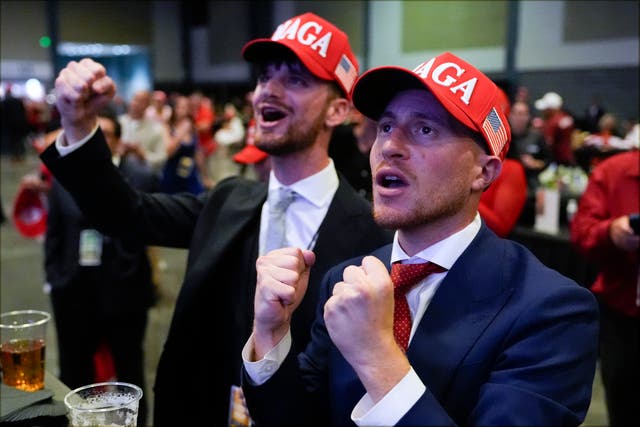Donald Trump elected US president to cap extraordinary comeback
He is the first person convicted of a felony to be elected president and, at 78, is the oldest person chosen for the office.

Donald Trump has been elected the 47th president of the United States.
The victory marks an extraordinary comeback for a former president who refused to accept defeat four years ago, sparked a violent insurrection at the US Capitol, was convicted of felony charges and survived two assassination attempts.
With a win in Wisconsin, Mr Trump cleared the 270 electoral votes needed to clinch the presidency.
The victory validates his bare-knuckle approach to politics. He attacked his Democratic rival, Kamala Harris, in deeply personal – often misogynistic and racist – terms as he pushed an apocalyptic picture of a country overrun by violent migrants.
The coarse rhetoric, paired with an image of hypermasculinity, resonated with angry voters – particularly men – in a deeply polarised nation.
As president, he has vowed to pursue an agenda centred on dramatically reshaping the federal government and pursuing retribution against his perceived enemies.

Ms Harris called Mr Trump on Wednesday to congratulate him on his victory, a senior aide said, adding that Ms Harris discussed the importance of a peaceful transfer of power ahead of a planned concession speech.
A short time later, Mr Biden also called Mr Trump to congratulate him and to invite the president-elect to the White House, formally kicking off the transition ahead of Inauguration Day, the White House said. Mr Biden also called Ms Harris.
The results cap a historically tumultuous and competitive election season that included two assassination attempts targeting Mr Trump and a shift to a new Democratic nominee just a month before the party’s convention.
Mr Trump will inherit a range of challenges when he assumes office on January 20, including heightened political polarisation and global crises that are testing America’s influence abroad.

Ms Harris, the current vice president, rose to the top of the ticket after Mr Biden exited the race amid alarm about his advanced age.
Despite an initial surge of energy around her campaign, she struggled during a compressed timeline to convince disillusioned voters that she represented a break from an unpopular administration.

He is the first person convicted of a felony to be elected president and, at 78, is the oldest person elected to the office.
His vice president, 40-year-old Ohio Sen. JD Vance, will become the highest-ranking member of the millennial generation in the US government.
There will be far fewer checks on Mr Trump when he returns to the White House. He has plans to swiftly enact a sweeping agenda that would transform nearly every aspect of American government.
His Republican critics in Congress have largely been defeated or retired. Federal courts are now filled with judges he appointed. The US Supreme Court, which includes three Trump-appointed justices, issued a ruling earlier this year affording presidents broad immunity from prosecution.

It also found a country mired in negativity and desperate for change. Mr Trump’s supporters were largely focused on immigration and inflation – two issues that the former Republican president has been hammering since the start of his campaign.
Mr Trump’s language and behaviour during the campaign sparked growing warnings from Democrats and some Republicans about shocks to democracy that his return to power would bring.
He repeatedly praised strongman leaders, warned that he would deploy the military to target political opponents he labelled the “enemy from within”, threatened to take action against news organisations for unfavourable coverage and suggested suspending the Constitution.

While Ms Harris focused much of her initial message around themes of joy, Mr Trump channelled a powerful sense of anger and resentment among voters.
He seized on frustrations over high prices and fears about crime and migrants who illegally entered the country on Mr Biden’s watch. He also highlighted wars in the Middle East and Russia’s invasion of Ukraine to cast Democrats as presiding over – and encouraging – a world in chaos.
It was a formula Mr Trump perfected in 2016, when he cast himself as the only person who could fix the country’s problems, often borrowing language from dictators.
This campaign often veered into the absurd, with Mr Trump amplifying bizarre and disproven rumours that migrants were stealing and eating pet cats and dogs in an Ohio town.
At one point, he kicked off a rally with a detailed story about the legendary golfer Arnold Palmer in which he praised his genitalia.
But perhaps the defining moment came in July when a gunman opened fire at a Trump rally in Butler, Pennsylvania.
A bullet grazed Mr Trump’s ear and killed one of his supporters. His face streaked with blood, he stood and raised his fist in the air.
Weeks later, a second assassination attempt was thwarted after a Secret Service agent spotted the barrel of a gun poking through the greenery while Mr Trump was playing golf.

He was so isolated at the time that few outside of his family bothered to attend the send-off he organised for himself at Andrews Air Force Base, complete with a 21-gun salute.
Democrats who controlled the US House quickly impeached him for his role in the insurrection, making him the only president to be impeached twice. He was acquitted by the US Senate, where many Republicans argued that he no longer posed a threat because he had left office.
But from his Mar-a-Lago resort in Florida, Mr Trump – aided by some elected Republicans – worked to maintain his political relevance.
Kevin McCarthy, the California Republican who at the time led his party in the US House, visited Mr Trump soon after he left office, essentially validating his continued role in the party.





